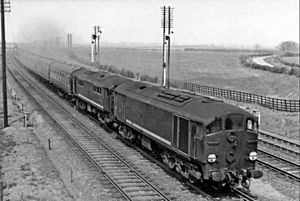British Rail Class 28 facts for kids
Quick facts for kids Metropolitan Vickers Type 2British Rail Class 28 |
|
 |
|
| Two 'Metrovicks' Nos. D5703 & D5710 passing through Millbrook in 1960 | |
| Power type | Diesel-electric |
|---|---|
| Builder | Metropolitan-Vickers’ Bowesfield Works, Stockton-on-Tees. |
| Build date | 1958–1959 |
| Total production | 20 |
| Configuration | Co-Bo |
| UIC classification | Co'Bo' |
| Gauge | 4 ft 8 1⁄2 in (1,435 mm) |
| Wheel diameter | 3 ft 3+1⁄2 in (1.003 m) |
| Minimum curve | 3.5 chains (70 m) |
| Wheelbase | 42 ft 9 in (13.03 m) |
| Length | 56 ft 7+1⁄2 in (17.26 m) |
| Width | 8 ft 6 in (2.59 m) |
| Height | 12 ft 1+1⁄2 in (3.70 m) |
| Locomotive weight | 97 long tons (98.6 t) |
| Fuel capacity | 510 imp gal (2,300 L; 610 US gal) |
| Prime mover | Crossley HST V8 |
| Traction motors | Metropolitan-Vickers 137BZ, 5 off |
| Transmission | DC generator, DC traction motors |
| Multiple working | ● Red Circle |
| Top speed | 75 mph (121 km/h) |
| Power output | Engine: 1,200 hp (895 kW) |
| Tractive effort | Maximum: 50,000 lbf (222 kN) |
| Train heating | Spanner steam generator of 1,500 pounds (680 kg) per hour |
| Train brakes | Vacuum |
| Career | British Railways |
| Number | D5700–D5719 |
| Axle load class | Route availability 8 |
| Retired | December 1967 – September 1969 |
| Disposition | One preserved, remainder scrapped |
The British Rail Class 28 was a type of diesel locomotive built for British Railways in the late 1950s. These powerful trains were originally called "Metropolitan-Vickers Type 2" locomotives. Only 20 of them were ever made. They were part of a big plan to make British railways more modern.
What Made These Locomotives Special?
The Class 28 locomotives had a very unusual design for British trains. They used something called a "Co-Bo" wheel arrangement. This means they had six wheels at one end and four wheels at the other end. This was unique in Britain, but some other countries, like Japan, used similar designs.
This special wheel setup meant that the weight of the train was not spread evenly. This could make maintenance a bit trickier. It also affected where these trains could travel on the railway lines.
Despite their unusual design, these locomotives were quite strong. They had a very high pulling power for their size. Because they had five driving axles (the parts that turn the wheels), they were less likely to slip on the tracks. This was a good thing when pulling heavy loads!
Where Can You See One Today?
Only one of these special locomotives has been saved! You can find D5705 at the East Lancashire Railway. It's a great chance to see a piece of railway history up close.
Images for kids


